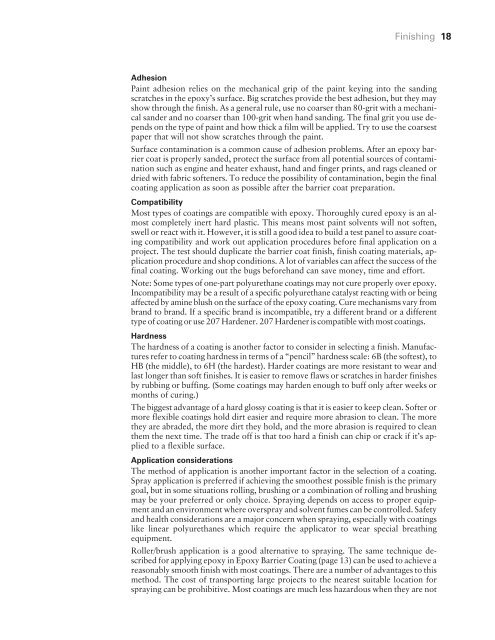Final Fairing & Finishing - WEST SYSTEM Epoxy
Final Fairing & Finishing - WEST SYSTEM Epoxy
Final Fairing & Finishing - WEST SYSTEM Epoxy
You also want an ePaper? Increase the reach of your titles
YUMPU automatically turns print PDFs into web optimized ePapers that Google loves.
<strong>Finishing</strong> 18<br />
Adhesion<br />
Paint adhesion relies on the mechanical grip of the paint keying into the sanding<br />
scratches in the epoxy’s surface. Big scratches provide the best adhesion, but they may<br />
show through the finish. As a general rule, use no coarser than 80-grit with a mechanical<br />
sander and no coarser than 100-grit when hand sanding. The final grit you use depends<br />
on the type of paint and how thick a film will be applied. Try to use the coarsest<br />
paper that will not show scratches through the paint.<br />
Surface contamination is a common cause of adhesion problems. After an epoxy barrier<br />
coat is properly sanded, protect the surface from all potential sources of contamination<br />
such as engine and heater exhaust, hand and finger prints, and rags cleaned or<br />
dried with fabric softeners. To reduce the possibility of contamination, begin the final<br />
coating application as soon as possible after the barrier coat preparation.<br />
Compatibility<br />
Most types of coatings are compatible with epoxy. Thoroughly cured epoxy is an almost<br />
completely inert hard plastic. This means most paint solvents will not soften,<br />
swell or react with it. However, it is still a good idea to build a test panel to assure coating<br />
compatibility and work out application procedures before final application on a<br />
project. The test should duplicate the barrier coat finish, finish coating materials, application<br />
procedure and shop conditions. A lot of variables can affect the success of the<br />
final coating. Working out the bugs beforehand can save money, time and effort.<br />
Note: Some types of one-part polyurethane coatings may not cure properly over epoxy.<br />
Incompatibility may be a result of a specific polyurethane catalyst reacting with or being<br />
affected by amine blush on the surface of the epoxy coating. Cure mechanisms vary from<br />
brand to brand. If a specific brand is incompatible, try a different brand or a different<br />
type of coating or use 207 Hardener. 207 Hardener is compatible with most coatings.<br />
Hardness<br />
The hardness of a coating is another factor to consider in selecting a finish. Manufactures<br />
refer to coating hardness in terms of a “pencil” hardness scale: 6B (the softest), to<br />
HB (the middle), to 6H (the hardest). Harder coatings are more resistant to wear and<br />
last longer than soft finishes. It is easier to remove flaws or scratches in harder finishes<br />
by rubbing or buffing. (Some coatings may harden enough to buff only after weeks or<br />
months of curing.)<br />
The biggest advantage of a hard glossy coating is that it is easier to keep clean. Softer or<br />
more flexible coatings hold dirt easier and require more abrasion to clean. The more<br />
they are abraded, the more dirt they hold, and the more abrasion is required to clean<br />
them the next time. The trade off is that too hard a finish can chip or crack if it’s applied<br />
to a flexible surface.<br />
Application considerations<br />
The method of application is another important factor in the selection of a coating.<br />
Spray application is preferred if achieving the smoothest possible finish is the primary<br />
goal, but in some situations rolling, brushing or a combination of rolling and brushing<br />
may be your preferred or only choice. Spraying depends on access to proper equipment<br />
and an environment where overspray and solvent fumes can be controlled. Safety<br />
and health considerations are a major concern when spraying, especially with coatings<br />
like linear polyurethanes which require the applicator to wear special breathing<br />
equipment.<br />
Roller/brush application is a good alternative to spraying. The same technique described<br />
for applying epoxy in <strong>Epoxy</strong> Barrier Coating (page 13) can be used to achieve a<br />
reasonably smooth finish with most coatings. There are a number of advantages to this<br />
method. The cost of transporting large projects to the nearest suitable location for<br />
spraying can be prohibitive. Most coatings are much less hazardous when they are not
















